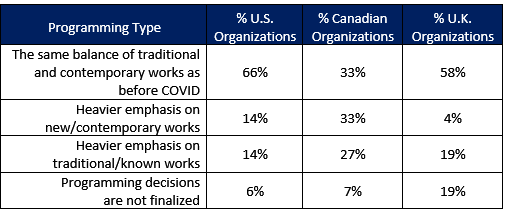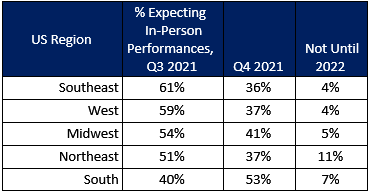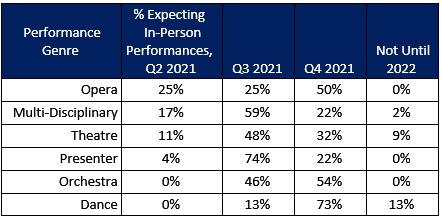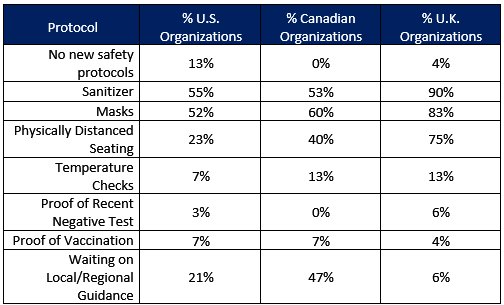TRG Arts Study Reveals Majority Of U.S. Performing Arts Orgs Expect In-Person Performances To Resume By October 2021
The study showed 94% of U.S. organizations plan to host live in-person performances by year end 2021.

More definitive guidelines on social gatherings are enabling U.S. arts and culture leaders' comeback plans, with 55% of U.S. performing arts organizations planning live, in-person performances before October 2021, according to a new study released today by international arts management consultants TRG Arts. The study, "Arts and Culture Comeback Planning: June 2021,"also reveals two-thirds of U.S. programming will be the same mix of traditional and contemporary works as before the pandemic, while an additional 14% will have a heavier emphasis on traditional or known works, which may indicate the desire for a semblance of "normalcy." This is the fifth in a series of studies on the plans of arts and culture organizations since the COVID-19 pandemic began.
Among the study highlights compiled from a survey of organizations in the United States, Canada and the United Kingdom:
• 2021 in-person performance - 94% of U.S. organizations plan to host live in-person performances by year end 2021.

• Programming - The minimal level of investment in new works at U.S. venues indicates that most organizations are not changing their approach post-pandemic, even with financial support such as Shuttered Venues Operator Grants and PPP loans.

• Ticket sales and demand - As of June 2021, 52% of U.S. organizations have not yet put multi-performance subscriptions on sale. Where subscriptions are on sale, demand is largely the same as pre-COVID. Where single event tickets are on sale, demand compared to pre-pandemic sales volume is weak.
• Openings by region - By region, more than half of U.S. organizations plan in-person performances by the end of Q3, except for the South (40%).

• Openings by genre - After an overall slow return to in-person performances across genres except opera in Q2 2021, organizations' plans to return improve in Q3. Presenter (74%), multi-disciplinary (59%), and theatre (48%) show the greatest optimism.

• Safety - COVID safety protocols will vary widely based on country and region. 13% of U.S. organizations expect the audience experience to remain unchanged from pre-pandemic, not requiring or requesting masking or other safety measures.

• Pricing - 71% of arts and culture leaders in all three nations have committed to keeping pre-pandemic ticket prices the same for their COVID comeback season. Of those who are anticipating a price increase, a majority are increasing prices by 10% or less. 13% of organizations are lowering prices compared to pre-pandemic, and 4% are offering "Pay What You Wish" for the coming 2021-22 season.
"The June Comeback Study finally brings news that we've all been eager to hear after more than a year of COVID ravaging our sector," said TRG Chief Executive Officer Jill S. Robinson. "The challenge for performing arts organization leaders is to create experiences that their audiences will find exciting and new, yet at the time somewhat familiar to reinforce the sense that we're back to 'normal.' As always, they must listen to their customers deeply and be prepared to take action."
Survey responses were collected from 226 organizations across all disciplines of performing arts in the U.S. (163), Canada (15), and the U.K. (48).
The full study of "Arts and Culture Comeback Planning: June 2021" is available at https://go.trgarts.com/ComebackStudyJune2021.
Ongoing Evaluation
TRG Arts is continually studying the impact of COVID-19 on the resiliency of the arts and culture field, and has made several resources free and available to all.
• TRG 30, a weekly 30-minute webinar series of crisis counsel and best practices that attracts hundreds of executives globally each week: https://go.trgarts.com/TRG30.
• TRG blog for the latest on COVID-19 related topics: https://go.trgarts.com/Blog
• COVID-19 Sector Benchmark, which has grown into the largest global arts and cultural consumer dataset in the industry, studies live transactional data from across the globe. It allows participants to compare their patron purchase trends to geographic-specific benchmarks and is intended to be used for arts advocacy and planning. Participating organizations can learn how their recovery compares to other similar organizations. Visit: https://go.trgarts.com/benchmark.
Comments
Videos

